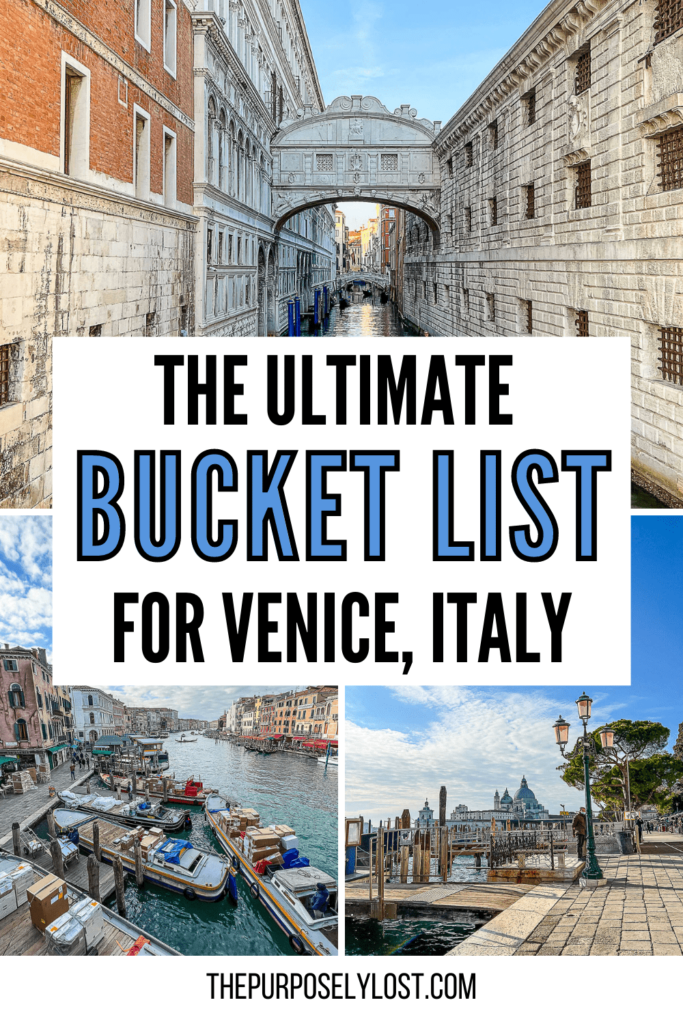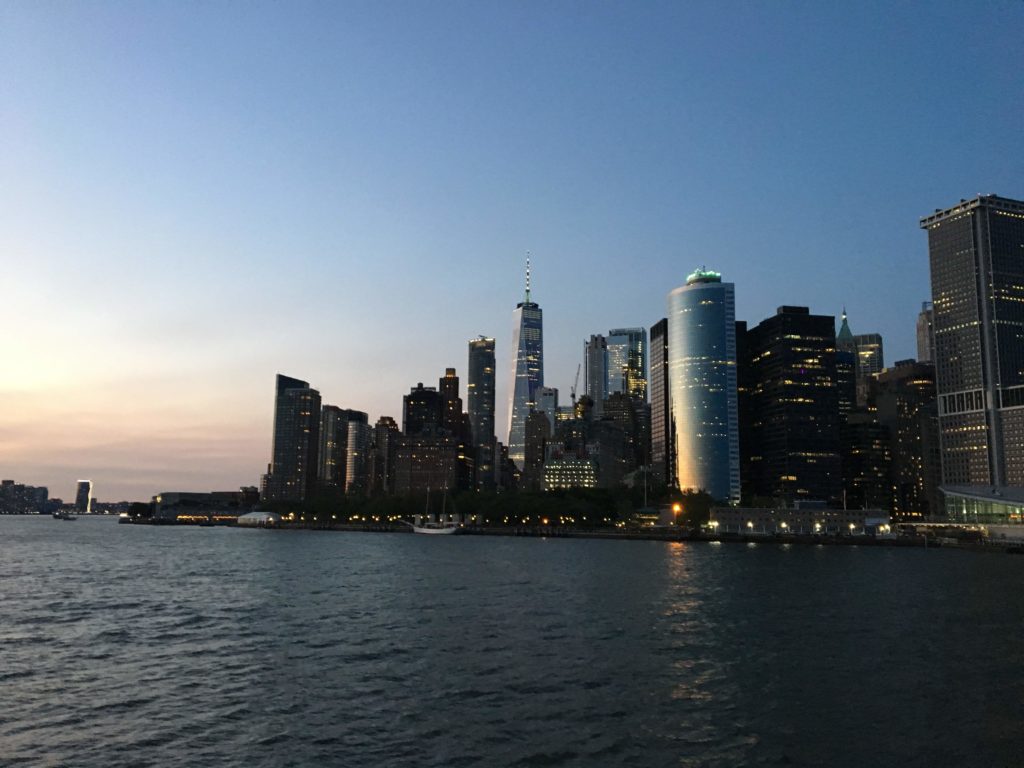Contents
- 1 The Ultimate Bucket List for Venice, Italy
- 1.1 Walk around Piazza San Marco
- 1.2 See the inside of Basilica di San Marco
- 1.3 Explore Palazzo Ducale
- 1.4 See the Bridge of Sighs
- 1.5 Climb the Campanile di San Marco
- 1.6 Check the time on the Torre dell’Orologio
- 1.7 Walk along the Riva degli Schiavoni
- 1.8 Enjoy Giardini Reali
- 1.9 Step inside the Biblioteca Nazionale Marciana
- 1.10 Learn more about Venice’s unique history at Museo Correr
- 1.11 Grab a Bellini at its birthplace–Harry’s Bar
- 1.12 Cross the Ponte di Rialto
- 1.13 Get lost on the city’s winding streets
- 1.14 Go on a guided walking tour
- 1.15 Instead of walking, catch a Vaporetto
- 1.16 Go for a ride in a Gondola
- 1.17 Learn how to row your own Venetian gondola
- 1.18 Or, take a traghetto
- 1.19 Try a dinner cruise on the Lagoon
- 1.20 Watch an opera at Teatro La Fenice
- 1.21 Attend the historic Carnevale festival
- 1.22 Buy or build a Venetian Carnevale Mask
- 1.23 Take a picture of the spiral staircase at Palazzo Contarini del Bovolo
- 1.24 Try a taste of authentic Venetian cuisine
- 1.25 Enjoy a glass of prosecco
- 1.26 Sip on a spritz
- 1.27 Taste traditional Venetian aperitivo on your own Bacaro tour
- 1.28 Cool down with Gelato
- 1.29 Shop for fresh seafood at the Mercato di Rialto
- 1.30 Visit the Dorsoduro neighborhood
- 1.31 See the world’s largest canvas painting at Chiesa di San Pantalon
- 1.32 Find the Banksy art
- 1.33 Walk to one end of the city at Punta della Dogana
- 1.34 Look up to see the dome at Basilica di Santa Maria Della Salute
- 1.35 Marvel at masterpieces in the Peggy Guggenheim Collection
- 1.36 Visit the Gallerie dell’Accademia
- 1.37 Take in the view from Ponte dell’Accademia
- 1.38 Visit the Floating Fruit Market
- 1.39 Check out the Canareggio and Castello neighborhoods on the north side of the city
- 1.40 Visit Chiesa di Santa Maria Assunta detta I Gesuiti
- 1.41 Learn at the Venetian Arsenal
- 1.42 Attend the Venice Biennale
- 1.43 Explore the city’s Jewish Quarter
- 1.44 Discover a classic at the Libreria Acqua Alta
- 1.45 Walk along the Calle Giazzo
- 1.46 See the tombs of twenty-five Doges at the Basilica dei Santi Giovanni e Paolo
- 1.47 Take a day trip to a nearby city
- 1.48 Enjoy the view from the Fondaco dei Tedeschi rooftop
- 1.49 Swim on Lido Island
- 1.50 Head inside the Church of San Giorgio Maggiore
- 1.51 Visit the three other Venetian islands–Murano, Burano, and Torcello
- 1.52 See the alter and flooded crypt in Chiesa di San Zaccaria
- 1.53 Check out what art exhibition is on display at Palazzo Grassi
- 1.54 Get a glimpse at historic fashion inside the Study Centre of the History of Textiles, Costumes and Perfume at Palazzo Mocenigo
- 1.55 See the city lights sparkle on the canals at night
This post may contain affiliate links! I will receive a commission, at no extra cost to you, if you purchase something recommended here.
There’s nothing quite like visiting Venice, Italy–walking down the Grand Canal with its gondolas gliding past. Getting lost while wandering the city’s narrow, twisted streets.
The unique city is full of history, culture, art, architecture, food, wine, and romance. It’s truly a city unlike any other.
If you’ve never been, then you owe it to yourself to experience the beauty of this incredible place.
I’ve been living in the Veneto region of Italy for months now, visiting the magnificent former Republic more times than I can count.
This is my personal Venice bucket list–the best places to visit and things to do in Venice, Italy.
The Ultimate Bucket List for Venice, Italy
If you need to distill all of this information down into a plan, I did that for you too! You can check out my complete 2 days in Venice itinerary for more.
Walk around Piazza San Marco

The beautiful, massive Piazza San Marco is one of the most famous piazzas in Italy. It takes its name from Saint Mark the Evangelist, the patron saint of the Basilica and whose symbol–the winged lion–was used to represent the Republic of Venice.
Located at the center of the historic district of Venice, the Piazza is surrounded by some of the finest buildings in the city. The Procuratie surrounds the Piazza on three sides. Its iconic arcade wrapped around into the Torre dell’Orologio on one side and the Biblioteca Nazionale Marciana on the other.
On the fourth side, this is where you’ll find the Basilica di San Marco and Palazzo Ducale (the Doge’s Palace).


The space in front of Palazzo Ducale connecting to the main piazza is called Piazzetta di San Marco. You can see two columns on this side of the square–Colonna di San Marco. At the top on the left, you can see the winged lion symbol for San Marco, but the other column on the right is a statue of Theodore of Heraclea. This saint with the part-crocodile-part-dragon beneath his feet was the original patron saint and symbol of Venice, before San Marco.
See the inside of Basilica di San Marco
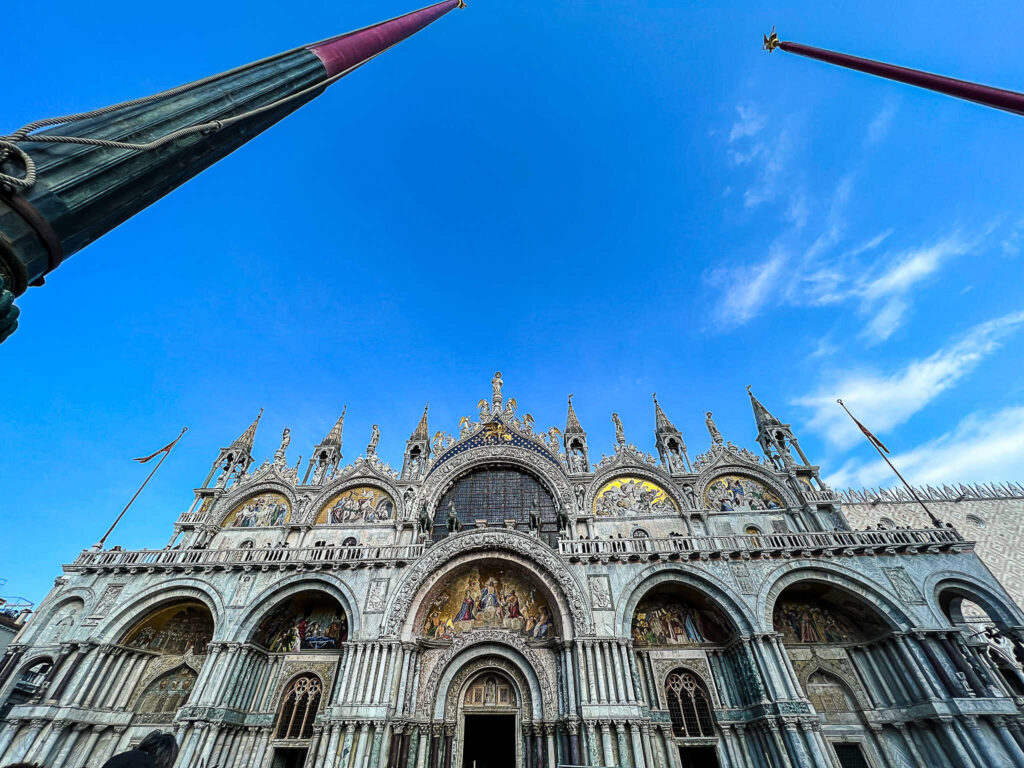
The Basilica di San Marco is located next door to the Palazzo Ducale (Doge’s Palace). Construction finished on the church in 1094 and served as the Ducal chapel from 836–200 years before this iteration of the building–through 1797. Before constructing this masterpiece, there were two other churches on this site.
The interior contains some of the most important works of art in all of Europe, including works by Renaissance masters Tintoretto, Titian, and Veronese, and relics of Saint Mark the Evangelist, the church’s patron saint.
During busy seasons, the line to enter the Basilica can be very long, so make sure to get there early in the day if you can.
Fun Fact: Many of the church’s embellishments were taken from other churches and palaces the Venetians pillaged. In particular, take a look at the four alabaster columns behind the main altar in this church. They are thought to have been taken from the Basilica di Santa Maria Assunta, a former cathedral in Pula, Croatia, the Venetians ransacked in 1243.
Explore Palazzo Ducale


Adjacent to Basilica di San Marco, Palazzo Ducale was built in the 14th century. This palace was used as a residence for the Doge of Venice until Napoleon overtook the Venetian Republic in 1797. Until Venice unified with Italy in 1866, the palace was used for administrative offices, exhibits, and cultural organizations.
Doge (n.) The highest official of the Republic of Venice for more than 1,000 years (from the 8th to the 18th century) and symbol of the sovereignty of the Venetian state. In Venice the office of Doge (from Latin dux, “leader”) originated when the city was nominally subject to the Byzantine Empire and became permanent in the mid-8th century.
From the 8th to the 12th century the Doge’s power was extensive, but all attempts to make the office hereditary failed. From the 12th century the aristocracy placed strict limits on the Doge. Newly developed constitutional bodies took over many of the functions of government, and the Doge on taking office had to swear an oath that restricted his freedom of action. During the same period, the main characteristics of the office were fixed: the Doge was chosen from among the ruling families of Venice and held office for life. By the 15th century the office had assumed the character of prince subject to law.
Britannica, T. Editors of Encyclopaedia (2011, December 12th). doge. Encyclopedia Britannica.
Now, the Doge’s Palace is a museum open to the public. It’s absolutely incredible inside. You’ll find stunning artworks, frescoes, and original furnishings, as well as grand chambers and halls where various government activities were formerly performed.
Standout sites include the Sala del Maggior Consiglio or Great Council Hall, where the doges met to discuss state affairs, featuring Paradiso (1588 – 1592) by Jacopo Tintoretto, the largest canvas painting in the world. And walking through the iconic Bridge of Sighs to reach the old prisons, just like the prisoners once did.
See the Bridge of Sighs

The Bridge of Sighs connects the prison cells across the Canal from the Doge’s Palace. Legend has it that criminals condemned to death would walk along the bridge between their cell and execution site, sighing deeply at each step.
The bridge was designed in the Baroque style by architect Antonio Contino and was built around 1600. You can see it from the inside as the prisoners did when you visit Doge’s Palace or from the outside along the Riva degli Schiavoni.
Climb the Campanile di San Marco

Every great church must have a beautiful bell tower–and the Campanile di San Marco is no exception. Construction began on the tower in the early 10th century. It took about 500 years with various periods of building to complete. Despite all that work, the building collapsed in 1902 but was accurately rebuilt by 1912.
As the tallest building in Venice, the Campanile offers incredible views of the city! You can purchase a ticket to enter and take the elevator to the top.
Fun Fact: The bells in the Campanile di San Marco rang 11 times per day at different intervals to signify the start or end of different parts of Venetian life–dawn, prayer, midday, the beginning and end of the workday, and more. It was also often hit by lightning, and the first lightning rod in Venice was installed at the top in 1776.
Check the time on the Torre dell’Orologio

The bell tower needs a corresponding clock! Just steps from the Basilica di San Marco, the Torre dell’Orologio is an iconic landmark in the heart of Venice. Built towards the end of the 15th century, it houses a clock that strikes every hour, marking the beginning and end of each part of Venetian life.
The two figures–one an old man and one a young man to represent the passing of time–strike the bell on top of the clocktower at the top of every hour. The winged lion holding an open book and the Zodiac marked into the clock face itself are other notable features.
Insider Tip: Each year, only on the Epiphany (January 6th,) the three Magi and an Angel appear from within the clock and pass in front of the Virgin Mary to celebrate the birth of Jesus Christ. This event is one of the most incredible things to see in Venice in winter!
The Torre dell’Orologio is now part of the Fondazione Musei Civici di Venezia (Venice Civic Museums Foundation). You should definitely head inside if you have the chance. You can purchase tickets individually or as part of the Venice Museum Pass.
Walk along the Riva degli Schiavoni


It seems the Croatians took the word for their beautiful seafront boulevards from the Venetians! Only steps from Piazza San Marco, you’ll find Riva degli Schiavoni running along the edge of the Grand Canal. This seaside promenade offers amazing views of the Dorsoduro, Giudecca, and San Giorgio Maggiore neighborhoods across the Canal.
Start at Giardini Reali, then follow the walkway to see the Bridge of Sighs from the outside while standing on Ponte della Paglia.
Walk along the water, enjoying the view as you pass the statue of Vittorio Emanuele II, and stop for a drink at one of the bars along the way.
Interested in visiting Croatia? I’ve spent several months in the beautiful Balkans country! You can check out all of my guides to several of the country’s major cities here.
Enjoy Giardini Reali
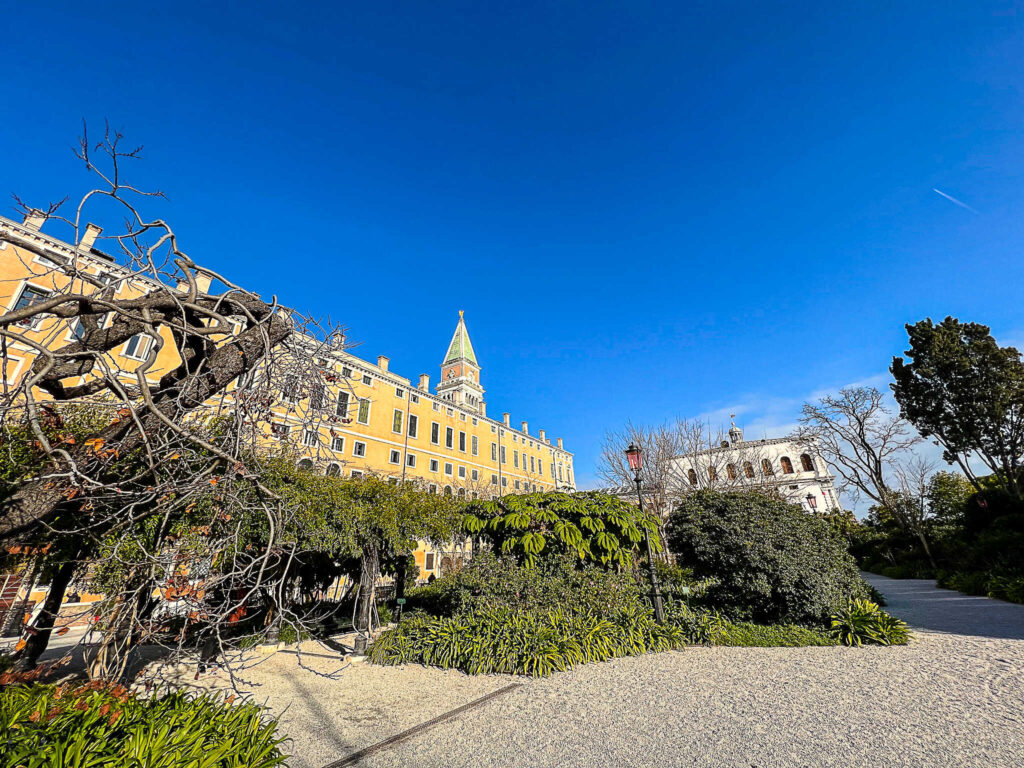
Alongside the Riva degli Schiavoni just steps from Piazza San Marco, you can find an oasis at Giardini Reali. The Royal Gardens of Venice were established once Napoleon took over the Venetian Republic. He asked for revitalizing the building and land that today houses the Biblioteca Nazionale Marciana.
After the fall of Napoleon and the Austrians took over, they added a greenhouse an upscale coffee house. They also opened the gardens to the public along Riva.
When the gardens are open, it’s a beautiful escape from crowds in the rest of the city. You can also stop for a coffee at the illy Caffè tucked inside.
Step inside the Biblioteca Nazionale Marciana
The national library of the Venetian Republic dates back to 1362 when a poet donated his books so the city could establish a collection. But it wasn’t until 1537 that the need for a library building was realized, and the Marciana Library opened as the Library of San Marco by 1560.
The library offers a free guided tour in Italian on the second Sunday of every month, as long as you register in advance. You can check their hours of operation and register for the tour on their website.
Learn more about Venice’s unique history at Museo Correr
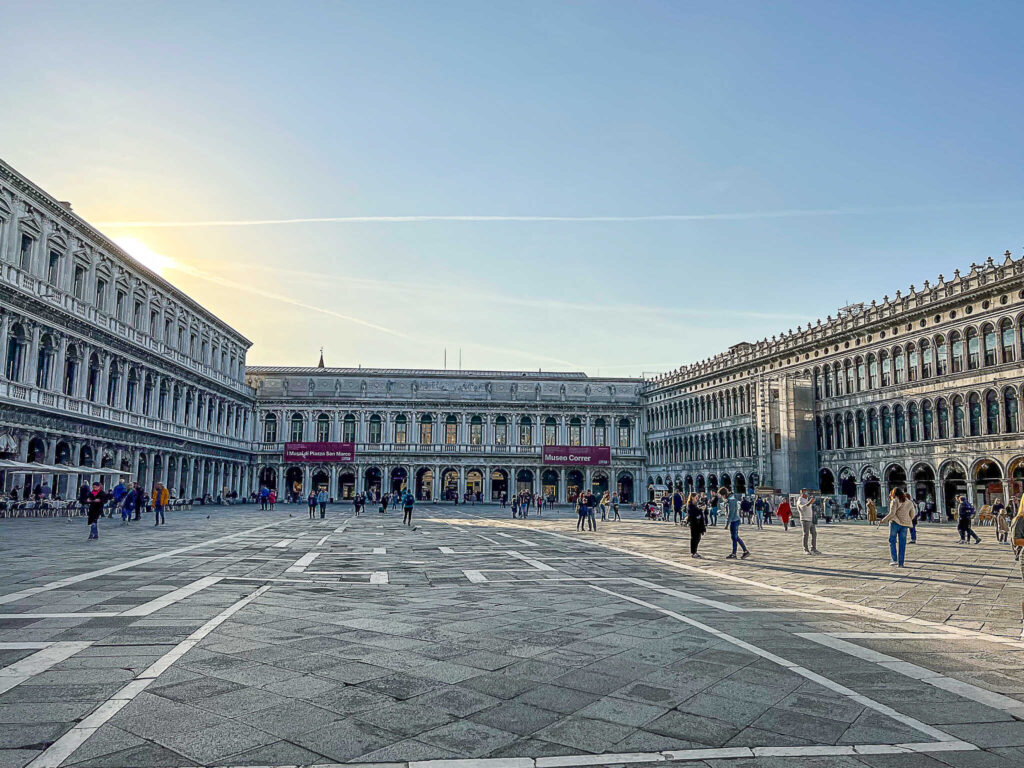
Also housed inside Piazza San Marco, Museo Correr explores Venice’s history through artwork and sculpture. In 1830, Venetian Teodoro Correr donated his art and literature collection on the history of Venice to the city with the request that it be made available for public viewing. The collection continued to grow throughout the rest of the 1800s and finally moved into its current location in 1922.
It’s an incredible glimpse into the Republic’s history through relics from Venetian noble families. As well as the remains of Napoleon’s neoclassic style and the Austrian royal Habsburg family–both of whom used the space as their royal palace after the country’s fall.
Tickets to Museo Correr are available online and included in the Venice Museum Pass.
Read More
- 20+ Things I Wish I’d Known Before Moving To Rome
- The Cost of Living In Rome, Italy: A Local’s Breakdown
- Venice vs Rome: Which Italian City Should You Visit?
- Your Guide for One Day in Pisa, Italy
- Your Guide to Teaching English in Italy with ACLE
- 50 of the Most Famous Landmarks in Europe
Grab a Bellini at its birthplace–Harry’s Bar
Have you ever sipped on a Bellini in the restaurant where it was created?
At the end of the Riva degli Schiavoni, you’ll come across the posh Harry’s Bar.
The classic brunch cocktail made with Prosecco and peach purée was created here at Harry’s Bar by owner Giuseppe Cipriani between the 1930s and 40s.
The color inspired the name of the drink. Cipriani noticed the drink’s signature pink color was similar to that in a painting by Venetian Renaissance painter Giovanni Bellini–thus, the Bellini was born.
Harry’s Bar is a great place to grab one of their famous drinks and relax outside on their terrace along the water during the summer season.
Cross the Ponte di Rialto
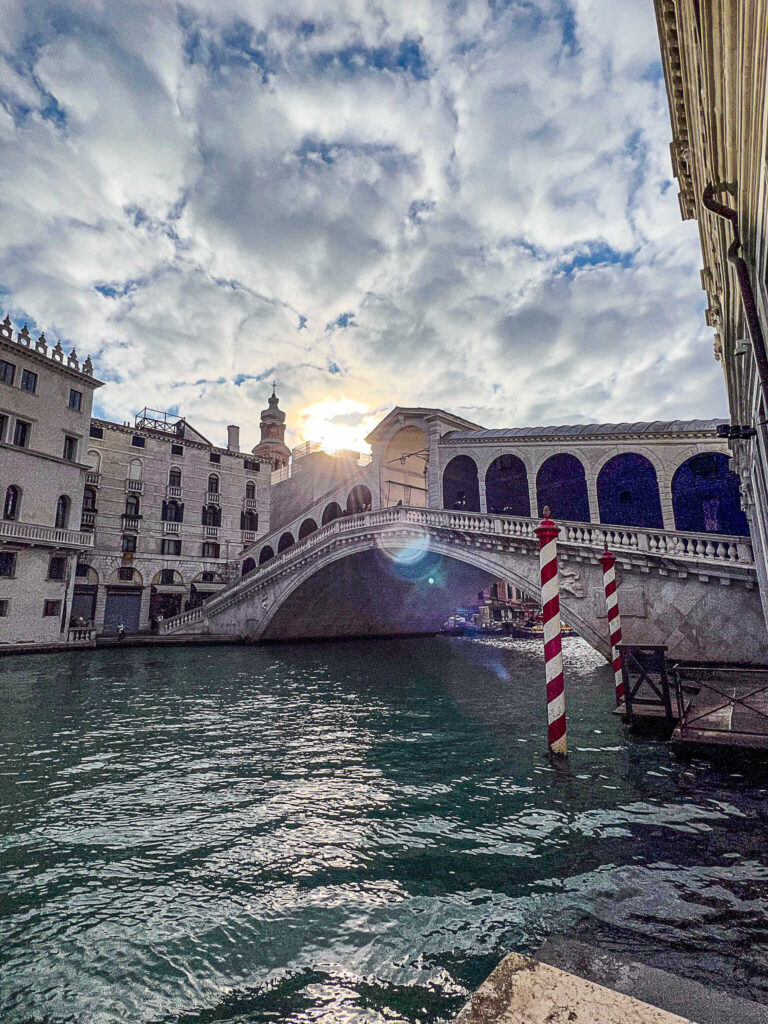


One of the most famous bridges globally, the Rialto Bridge crosses the Grand Canal, connecting two parts of the city. The famous bridge has witnessed some of the most important events in Venetian history.
Although you can also use the Ponte dell’Accademia and two others to cross the Canal, the Ponte di Rialto is the most central and the most famous. The first version of the bridge was constructed between 1181 as a pontoon bridge. As the market grew on the eastern banks of the river, the need for a sturdier bridge also grew. It was replaced with a wooden structure about 50 years later.
Fun Fact: The wooden Rialto Bridge collapsed twice over the centuries due to too much weight–once in 1444 and 1524.
It wasn’t until the early 1400s that the bridge’s iconic shops were first established. Still, today’s famous stone bridge wasn’t completed until 1591. Today, the Rialto remains one of the most iconic landmarks in Venice. Cross over the Grand Canal from one side of the city to the other, and take in the beautiful views from both sides.
Get lost on the city’s winding streets

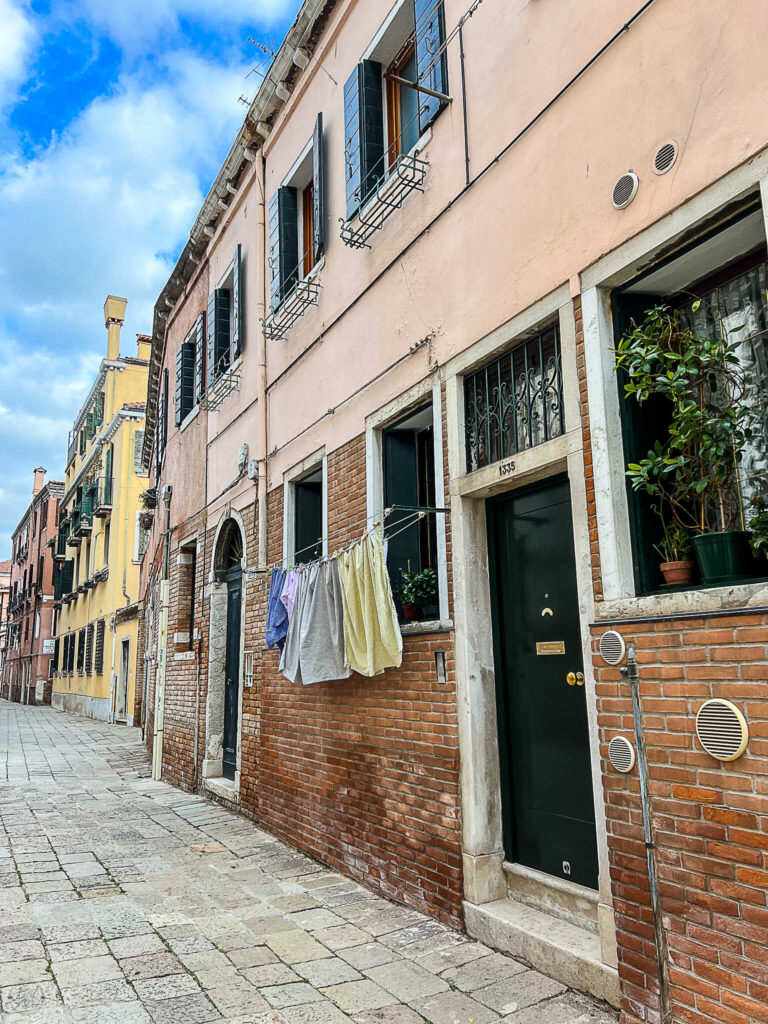
During the height of the Venetian Republic, the main streets people used to travel were canals. The streets we walk along when we’re wandering around Venice today used to be for staff of wealthy families, everyday folks, and animals to move around. So they weren’t built with an order in mind. That means it’s easy to get lost while wandering around the city today.
But that’s A-OK! As you explore the city, you’ll come across great artisan shops, bakeries, and smaller monuments and museums you might not have found without getting a little lost. Actually, I stand by the idea so much that you’re reading this on a website called The Purposely Lost *wink.*
Fun Fact: One of the world’s most narrow streets is found here in Venice. Calle Varisco is only 53cm wide, making it one of the most narrow streets in the world. You can find more interesting facts about Venice here!
Go on a guided walking tour
One of the best things to know before visiting Venice is that you need to take a guided walking tour. It’s a fantastic way to learn more about the city.
I took an excellent free walking tour of the two northern neighborhoods, the Cannareggio and Castello districts, with GuruWalk. It gave me a great perspective on what local life is like in Venice today and the history of these underrated neighborhoods.
However, if you want a walking tour of the more famous areas, like Piazza di San Marco, the Rialto Bridge, and take a look at these guided walking tours:
Instead of walking, catch a Vaporetto
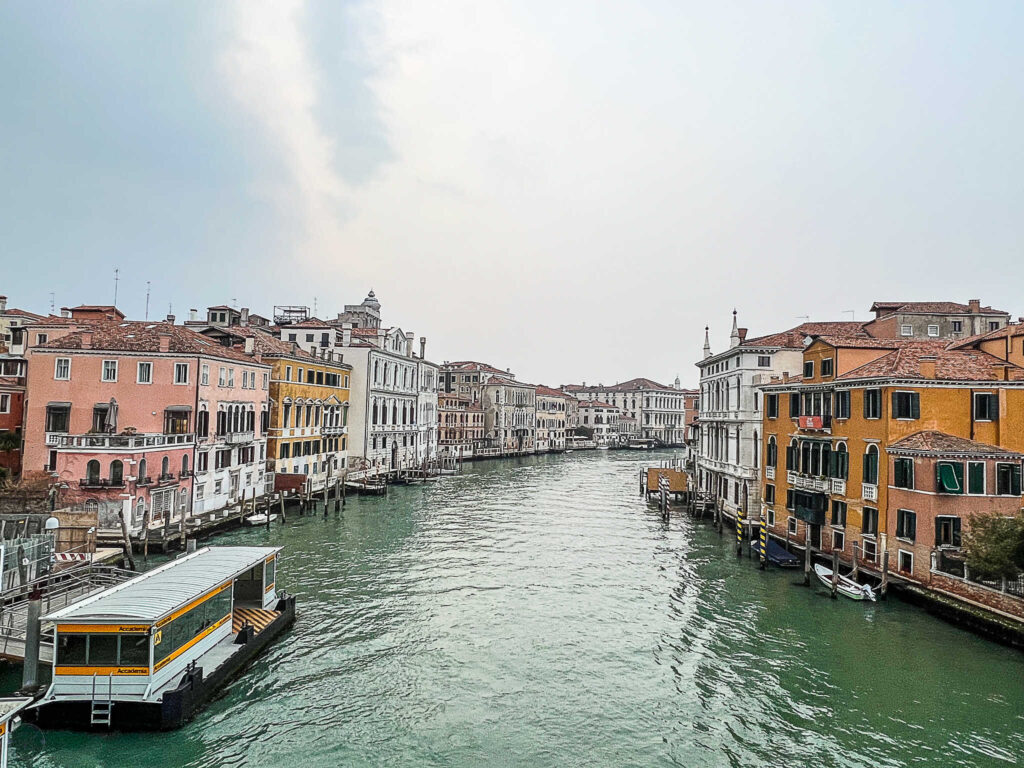
Walking through Venice’s winding streets is an incredible experience, but there’s usually a more direct route–on the water.
A water taxi ride along the Grand Canal of Venice is an unforgettable experience. You’ll pass under the Rialto Bridge, along waterways lined with colorful houses and gondolas, and experience the city as it was meant to be.
Like any other mass transit system, the city’s public Vaporetto system is straightforward to use once you learn the basics. 19 different lines move between various points throughout the city and the nearby islands of Burano, Murano, and Torcello.
You can read more about its history, plan your routes, and purchase tickets on the Azienda del Consorzio Trasporti Veneziano (Actv) website.
Insider Tip: My favorite transit app for the New York City subway system also works in Venice! Citymapper is excellent–you put in your current location and where you want to go. It lists out all the different options available to you. In Venice, that includes the Vaporetto!
Go for a ride in a Gondola

One of the most extraordinary things about Venice are the canals–and riding on a gondola through the canals is an absolute treat.
You can rent a boat for as little as $10 per hour. If you want to take a private tour, you’ll pay anywhere from $50-$100 per person, depending on how many people are in your group.
You can choose between booking a traditional wooden gondola tour in advance or heading out with a gondolier promoting his work on the street. You’ll get a great view of the city, visiting hidden spots where you might not otherwise go either way.
However, I recommend booking this Grand Canal by Gondola with Commentary bucket list in Venice experience in advance–that way, you’ll have a definite meeting point. And, you can pay for the fixed price of the service ahead of time with your favorite digital payment method.
Fun Fact: You can’t swim in the canals in Venice. The water is polluted, and you’ll recieve a fine if you’re caught.
Learn how to row your own Venetian gondola
Rowing is a real part of the local and historic culture of the city, which makes it a great addition to your Venice bucket list! Your trained gondolier will teach you the basics of how to control a gondola in the traditional Voga alla Veneta way before you all head out into the canal where you’re rowing your own.
You can check availability and book your lesson here.
Or, take a traghetto
Take a traghetto if you want to experience a gondola ride the local way. Since there are only two significant bridges (and four overall) that cross the Grand Canal, locals often find themselves needing to get across from one side to the other without all the fuss of the Vaporetto or the time for walking.
Instead, they take a traghetto for the convenience of moving a short distance. Now, it won’t come with all of the commentaries of a touristic gondola ride or wind through narrow canals between islands. Still, it will give you an authentic gondola ride on a budget!
Whether you opt for the full gondola ride experience or enjoy the short distance of a traghetto–either way, you’re guaranteed to enjoy the iconic experience.
Try a dinner cruise on the Lagoon
One of the most popular ways to explore Venice is aboard a water taxi. But if you want really want an intimate experience on the sea, consider taking a cruise on the lagoon.
On this Venetian Lagoon Tour and Galleon Dinner cruise, experience the city in the evening as you enjoy a romantic dinner by candlelight.
You’ll get to see some of Venice’s smaller islands backed by a beautiful sunset as you sail through the lagoon. Then make your way along the Grand Canal and watch the street lamps shimmer on the water as evening turns to night.
Read More
- Your Guide to 2 Days in Salzburg, Austria
- The Most European Cities in North America
- The Top Travel Experiences & Best Tours Around the World
Watch an opera at Teatro La Fenice



Teatro La Fenice opened in the 18th century, just five years before the end of the Republic. Throughout its history, operas from some of the most influential composers like Rossini, Bellini, Donizetti, and Verdi premiered here. It’s now considered one of the most important landmarks in the history of opera. Today’s theater is actually a reconstruction of the original–it was destroyed by arson in 1996.
Fun Fact: The inside of the Croatian National Theater in Šibenik’s theater was inspired by Teatro La Fenice! You can see a picture of the interior in my guide on the best things to do in Šibenik, Croatia.
If you’ve been around here at The Purposely Lost for a while, you might know that before moving to Italy, I was an auditioning actor and licensed New York City tour guide. With a Bachelor of Fine Arts in Theatre encompassing history, performance, and production, visiting this theater was one of my absolute Venice bucket list experiences. It was everything I could’ve imagined and more!
If you want to attend a performance here yourself, you can check their calendar and book tickets online. Otherwise, you can book an audio tour of La Fenice when there isn’t a production in process.
Attend the historic Carnevale festival



Carnevale is an Italian tradition dating back hundreds of years when people dress up in costumes and parade through the streets during February. They celebrate with regattas, masquerade balls, and much more. Today, Carnevale festivities last for three weeks preceding the season of Lent in the Roman Catholic religion and end on Fat Tuesday.
One of the celebration’s highlights is the Carnevale ball held every year in Piazza San Marco. The entire Piazza is transformed into a massive celebration space where you can see the best of people’s costumes during the event.
I finally had the opportunity to attend Carnevale, and it was a Venice bucket list experience for sure!
Fun Fact: The word “Carnevale” comes from the Latin carnem and levare, which literally translates to “to remove meat.”
Buy or build a Venetian Carnevale Mask

The tradition of mask-wearing and mask-making is weaved into the history of Venice’s Carnevale celebrations. The origins of these traditions date back centuries; starting in the Middle Ages, masks were worn to hide the wearer’s identity so they could partake in the Carnivale reverie undetected.
You can find masks at the market near the Rialto Bridge or just about any tourist shop in the city at any time of the year, not just during the season of Carnevale. If you want something more authentic, you can buy a mask at one of the city’s specialty shops, where artists still follow the time-honored mask-making techniques.
For the ultimate souvenir, attend a mask-making class with a Venetian artisan. You’ll learn about the tradition of Venetian paper-mâché masks and how the art form was almost lost while painting your own to bring home.
Take a picture of the spiral staircase at Palazzo Contarini del Bovolo

Tucked away along down one of Venice’s narrow alleyways, you’ll come across one of the most non-touristy places to visit in Italy–Palazzo Contarini del Bovolo. This mansion underwent significant renovations in the 15th century for the Contarini family.
There are 80 steps on this “snail” staircase (bovolo in Italian translates to snail) connecting six loggia floors. Alternating bricks and white stone from the Istria region of Croatia create the decoration.
You can purchase a ticket to visit the inside of the palazzo, and of course, climb the stairway to the Belvedere at the top.
Fun Fact: Orson Welles featured Palazzo Contarini del Bovolo in his film version of Shakespeare’s Othello.
Try a taste of authentic Venetian cuisine
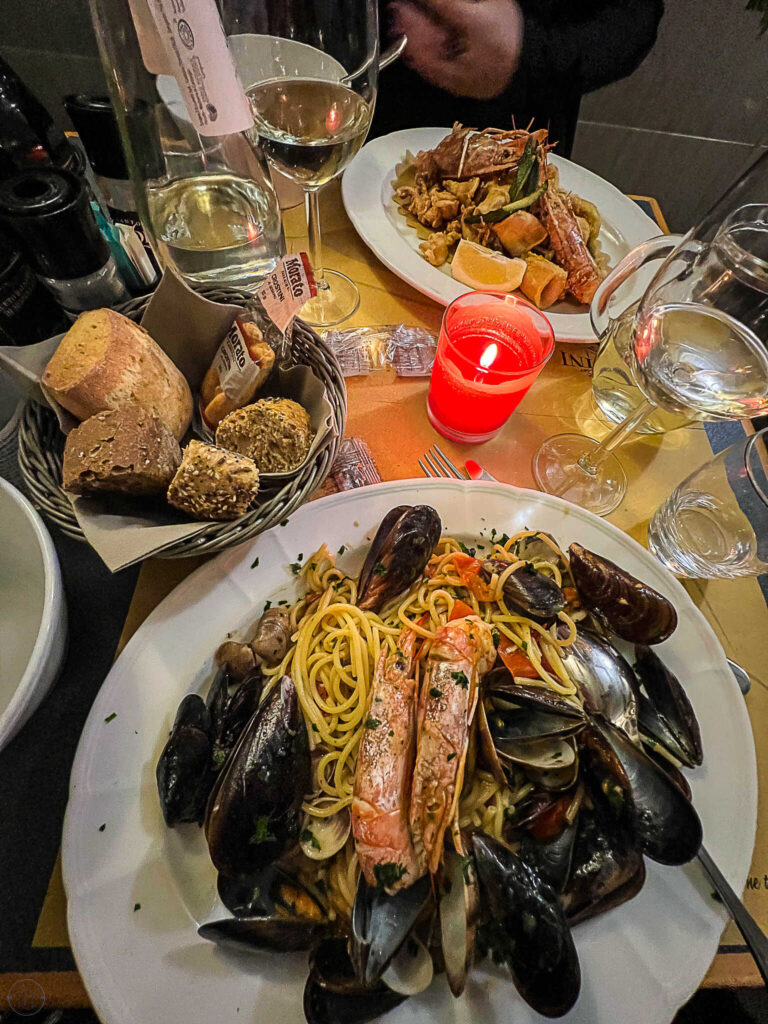

Food is an important part of my life, and of Italian life in general. I enjoy savoring local dishes as much as possible, and Venice is no exception.
Venetian cuisine is famous throughout Italy for its fresh seafood and fine wines.
The lagoon is the main source of fish in this region, which means you’ll find many of the local dishes revolve around la frutta di mare (the fruit of the sea):
- Baccalà – dried salt cod
- Risotto al nero di seppia – risotto with cuttlefish ink
- Scampi in busara – cooked shrimp in a tomato sauce
- Sarde in saor – fried sardines with onions, pine nuts, and raisins
- Fritole alla veneziane – a sweet fritter made in the Veneto region only during Carnevale season
If you’re interested in learning more about Venetian cuisine, why not take a cooking class while you’re visiting?
Enjoy a glass of prosecco


Prosecco is the perfect beverage to pair with Venice’s signature seafood dishes or as a sweet treat. The bubbly white wine is like Italy’s version of France’s champagne.
Named after the Italian city Prosecco, authentic bottles of the wine can only be produced with the Prosecco grape in a zone which spans the Friuli Venezia Giulia and the Veneto regions of the country.
And just in the last few years, the laws regarding Rosé Prosecco have changed, and it’s now legal to produce! You can find the traditional white Prosecco on pretty much every drinks menu throughout the city.
If you really want to experience Prosecco at its best, you should consider taking one of these Prosecco vineyard tours from Venice.
You’ll have the opportunity to learn more about the process behind the wine’s signature Charmat method while sampling the light bubbly white wine.
And since there isn’t a set drinking age in Italy, a Prosecco tour is an amazing addition your bucket list for Venice.
Sip on a spritz
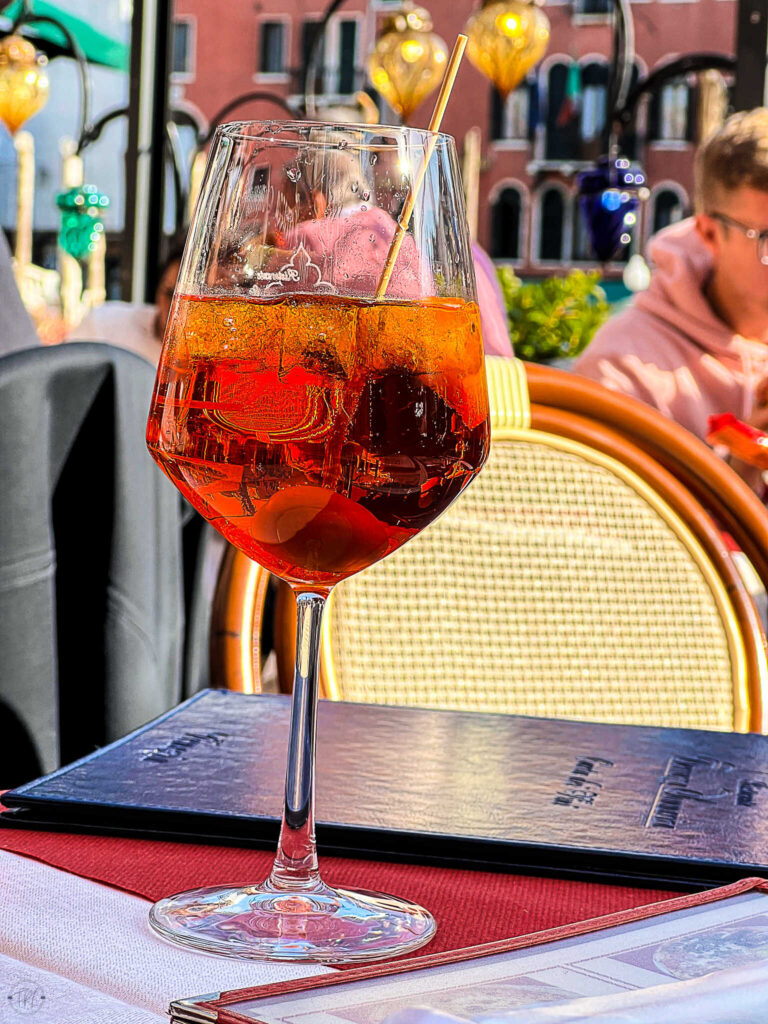
A spritz is a bright orange alcoholic drink, traditionally served in the Veneto Region of Italy.
It’s usually made Prosecco, soda water–and either Aperol (sweet) or Campari (bitter). You can also order a spritz misto which is half of each. Topped with ice and a slice or two of orange, this delicious drink is the cocktail of choice in the Veneto.
It’s even become so popular that it has made its way into restaurants and bars around the world, so next time you’re at the bar, ask for an Aperol spritz!
Taste traditional Venetian aperitivo on your own Bacaro tour

The word bacaro in Venetian dialect means “a good bar” or “wine,” and that’s precisely what you’ll find at any of the city’s bacaro restaurants.
At a bacaro, you’ll eat the Venetian happy hour delicacy called cicchetti, which are small rounds of Italian bread each topped with different things–baccalà, salami, gorgonzola with walnuts, parmigiana cheese with jam, and so many other foods. And of course, you’ll drink a spritz!
Now that you’ve got the basics down, you’re going to do as the Venetians do and add un giro d’ombra (a bacaro tour) to your Venice bucket list! Go from one bacaro to another, having a spritz and a few pieces at cicchetti at every stop.
You can do this on your own or take a guided bacaro tour:
Cool down with Gelato

Gelato has become an Italian institution over the last few decades. And you can find a gelateria all over Venice. If you’re looking for a sweet treat after exploring the city, stop into one of my favorite spots for delicious ice cream:
- Gelateria S. Leonardo
- Bacaro del Gelato
- Gelato Fantasy
- Gelatoteca Suso
- Gelateria Nico
Shop for fresh seafood at the Mercato di Rialto

You won’t be able to miss this smell!
The Mercato di Rialto is Venice’s fresh fish and produce market found near the Rialto Bridge in Campo de la Pescaria.
It sells a variety of seafood including fresh fish caught daily by local fishermen, but make sure to get there early since the market closes in the afternoon.
The market is open every morning Tuesday through Saturday.
Read More
- Your Guide to the Best Things to do in Split, Croatia
- Your Guide to 3 Days in Split, Croatia
- The Best Beaches in Split, Croatia
- Your Guide to the Best Things to do in Šibenik, Croatia
- The Best Beaches in Šibenik, Croatia
- Excellent Gift Ideas for the Beach Lover in Your Life
Visit the Dorsoduro neighborhood
The Dorsoduro sits between the Grand and Giudecca Canals. It has the most land of all Venetian neighborhoods. It’s home to several of the city’s world-renown institutions like the Peggy Guggenheim Collection, Cà Rezzonico, and Gallerie dell’Accademia.
It’s also home to the beautiful Basilica di Santa Maria della Salute, Scuola Grande dei Carmini, excellent restaurants, and Università Ca’ Foscari.
See the world’s largest canvas painting at Chiesa di San Pantalon
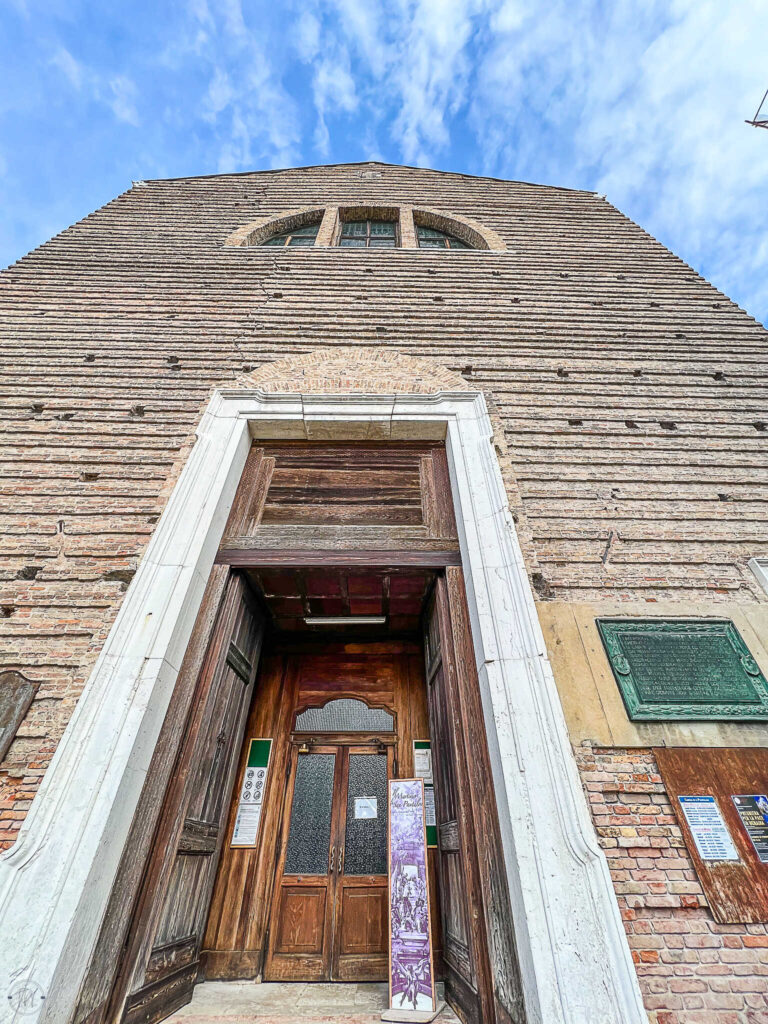
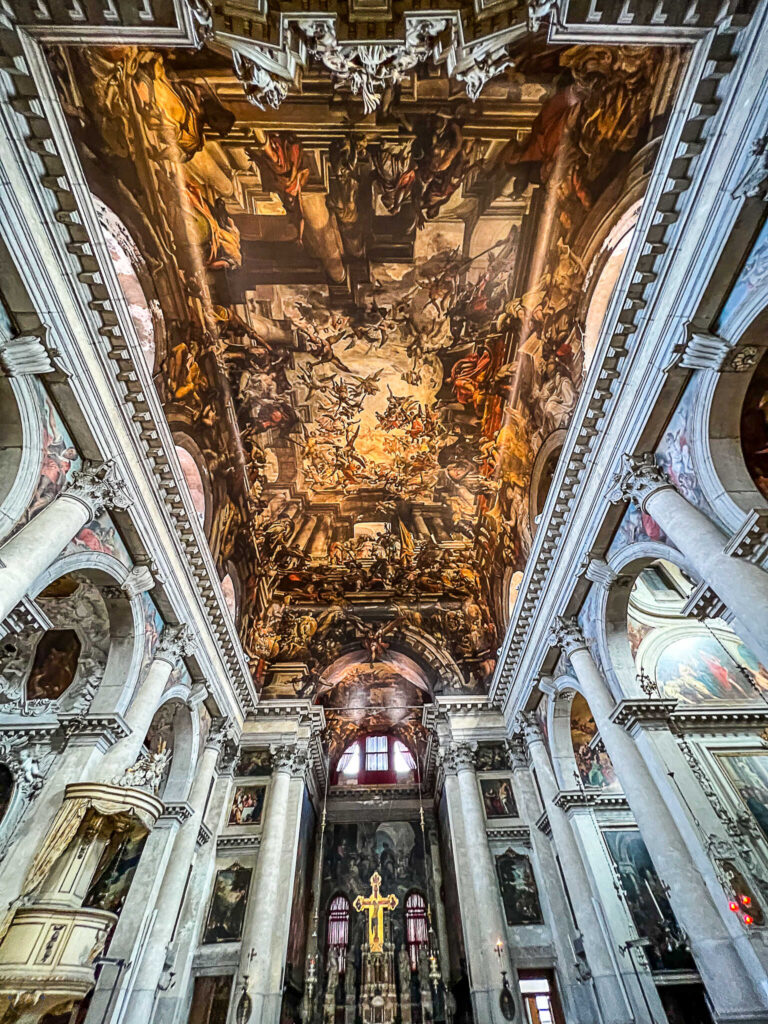
This unassuming church in the Dorsoduro district has an incredible masterpiece inside. The church dedicated to Saint Pantaleon was built in the 17th century. It’s home to Il Martirio di San Pantalon (The Martyrdom and Apotheosis of St Pantalon,) the largest canvas painting in the world. It spans more than 40 canvases over the 25-by-50-meter space.
The Baroque artist, Gian Antonio Fumiani, worked on the vast ceiling illustration for over 20 years but passed away when he fell off the scaffolding keeping him up close to the roof while working.
The first time I saw the masterwork, I had unknowingly wandered into the church. I was awestruck by the painting above my head. It’s an incredible landmark that you need to see at least once.
Find the Banksy art

Right by Chiesa di San Pantalon, one of the world’s most famous anonymous street artists left a gift in Venice. Banksy left his piece Opera di Banksy Piccolo migrante col razzo (The Migrant Child by Banksy) on the side of a building in the Dorsoduro neighborhood. It’s best viewed from the bridge Calle de la Chiesa in the Dorsoduro district.
Walk to one end of the city at Punta della Dogana

Found at the end of the Dorsoduro neighborhood, Punta della Dogana marks the spot between the Grand and Giudecca Canals. It’s at one of the furthest points you can walk to in Venice, but it makes for excellent views once you get there. It’s one of my favorite underrated Venice sunset spots due to how the sun reflects on the water over the narrow strip of land.
Here you’ll find the Patriarchal Seminary of Venice, the Basilica di Santa Maria Della Salute, and a contemporary art museum in the 17th century Dogana da Mar customs house.
Look up to see the dome at Basilica di Santa Maria Della Salute


Almost at the end of Punta della Dogana, you’ll find Basilica di Santa Maria Della Salute. Built starting in 1631, this church stands over the Grand Canal as a dedication to Our Lady of Health to save Venice from the plague.
The ceiling is covered with paintings by famed Venetian Renaissance artist Titian, depicting stories from the Old Testament, such as Abraham and Isaac, Cain and Abel, and David and Goliath. The Basilica is free to enter.
Marvel at masterpieces in the Peggy Guggenheim Collection
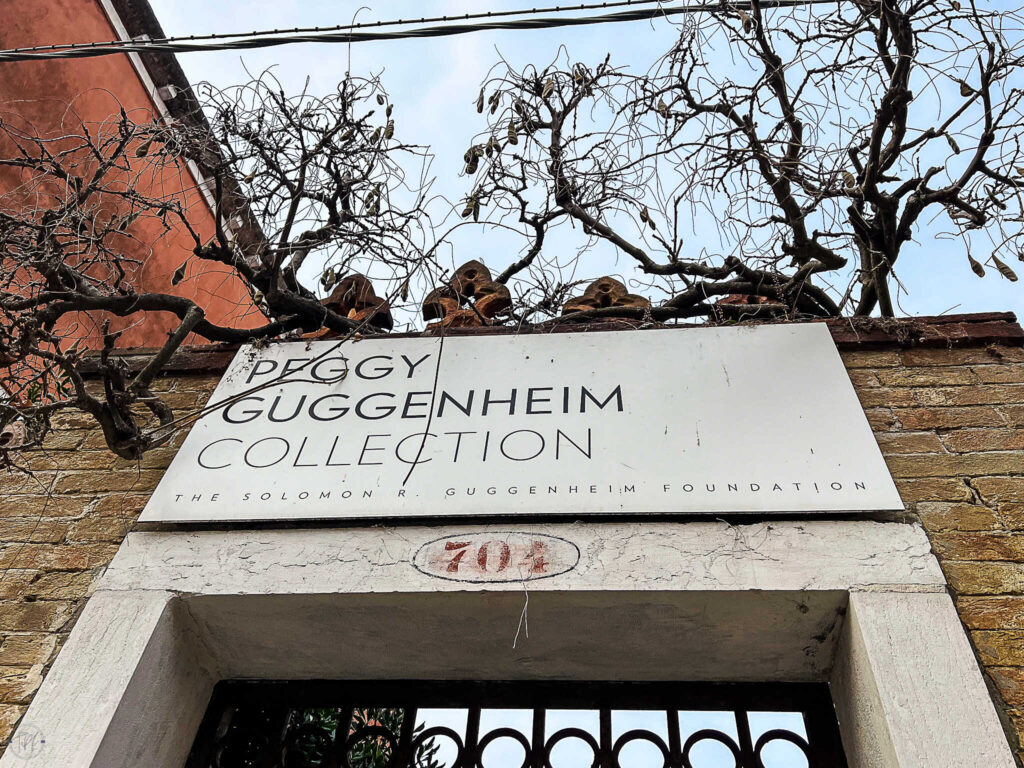
The Peggy Guggenheim Collection is found in an 18th-century palazzo overlooking the Grand Canal in the Dorsoduro neighborhood. Walk through the mansion Guggenheim lived here for over thirty years and admire the collection she amassed and publically displayed seasonally before she passed in 1979.
The museum has an impressive collection of modern art and sculpture, most of which Penny Guggenheim purchased throughout Europe and the United States during World War II. Cubism, Surrealism, and abstract expressionism are styles on prominent display from artists like Gino Severini, Pablo Picasso, Marcel Duchamp, and Jackson Pollock.
The museum is open year-round (except for Tuesdays) and is included as an add-on for the Venice Unica Pass.
Visit the Gallerie dell’Accademia
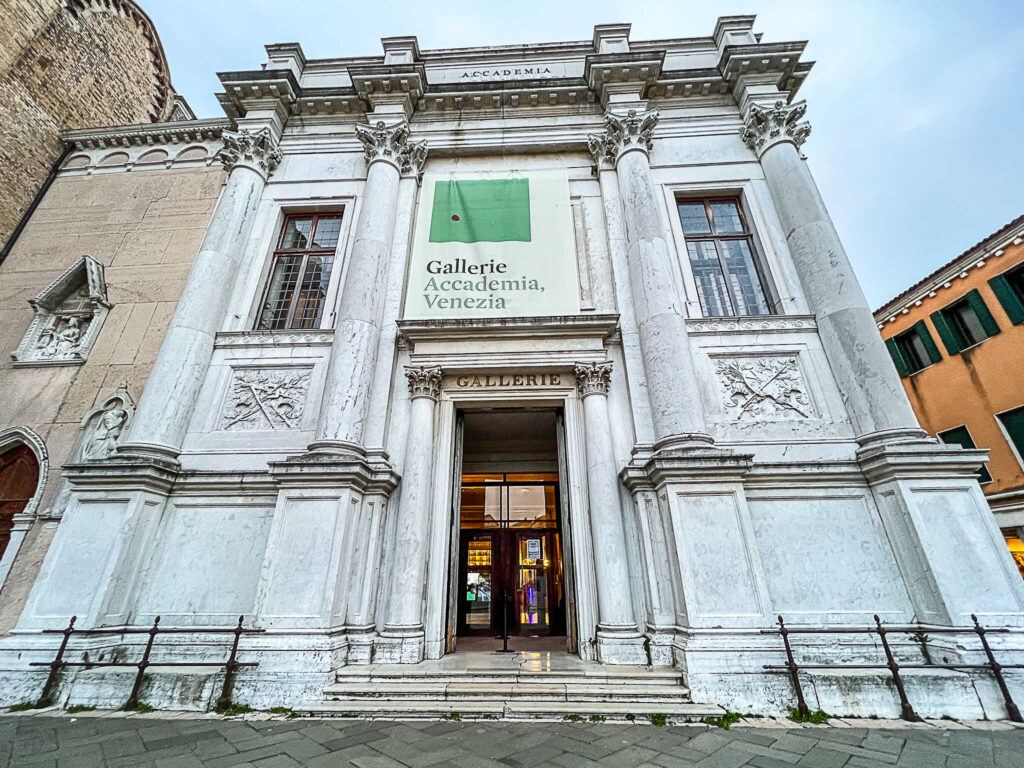
The Gallerie dell’Accademia houses an impressive collection of Venetian art and paintings from the pre-19th century. Housed in the former Scuola della Carità building, the gallery shows its masterpieces in chronological order from when they were created.
As you wander the halls, you’ll be in the presence of works by artists such as Giovanni Bellini, Leonardo da Vinci, Giovanni Battista Tiepolo, Tintoretto, Titian, and Giorgio Vasari, among others.
Take in the view from Ponte dell’Accademia

The Ponte dell’Accademia is one of the most photographed bridges in Venice. It connects the Dorsoduro district to the San Marco neighborhood. Any time of day on the bridge is pretty beautiful, but it’s absolutely magical around sunset. Basilica di Santa Maria della Salute glows gold in the evening light, and with a sunset backdrop–it’s gorgeous.
Visit the Floating Fruit Market
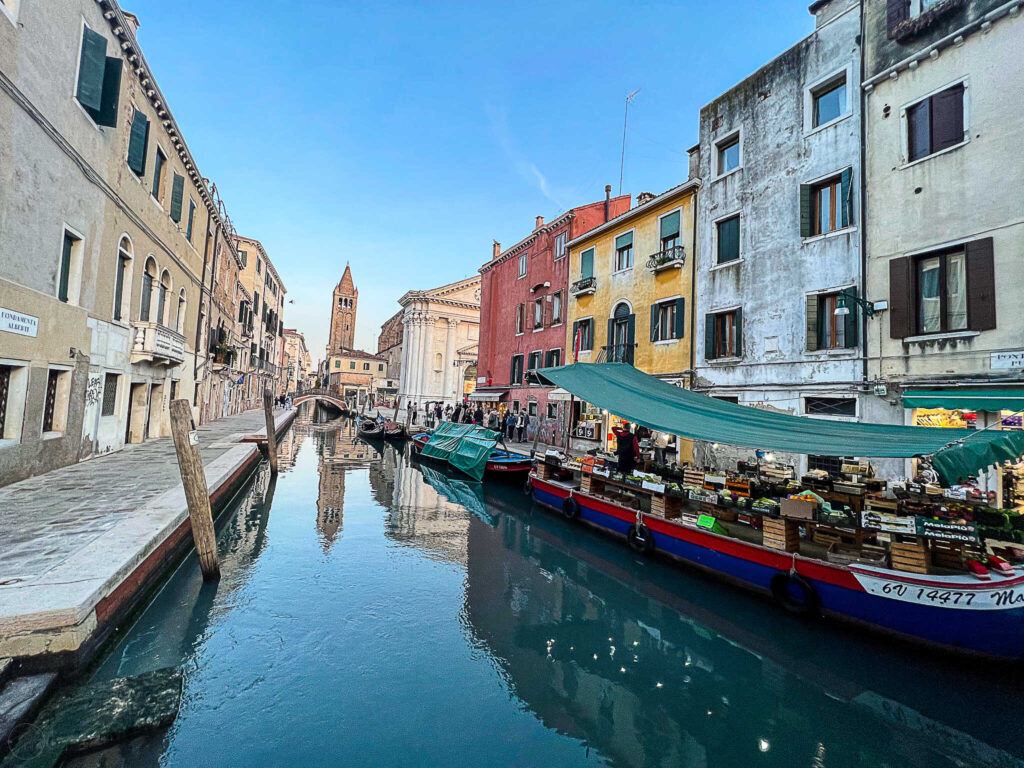
If everything else in Venice floats, why not its fruit market? That’s right, you can find gondolas filled with fresh produce near the Ponte dei Pugni bridge in the Campo San Barnaba of the Dorsoduro district.
Read More
- Great Gifts for Friends Going Abroad They’ll Actually Be Excited To Take With Them
- Your Guide to Create Stunning Mixbook Travel Photo Books
- The Most Important Things to do Before Traveling
- Your Guide to the Best Travel Essentials for Women
Check out the Canareggio and Castello neighborhoods on the north side of the city
There are so many amazing things to do in Venice, you’ll soon realize why everyone loves visiting this beautiful city. When you’re tired of walking around the crowded tourist attractions, take a stroll down some quiet streets of the Canareggio and Castello neighborhoods.
There are only about 50,000 residents of Venice today, and a good portion of them live within the Canareggio and Castello districts. If you want to see what local living in Venice is like today, this is where you need to go. You’ll also find some excellent restaurants and lesser-known historical landmarks here.
The Fondamente de la Misericordia is the heart of local life in this area; you’ll find many excellent restaurants where people are eating right next to the Canal.
Then, walk along the northern edge of the city to see Cimitero di San Michele (San Michele Cemetery) island just a little ways off-shore and the snow-capped peaks of the Dolomites on a really clear day far off in the distance.
Visit Chiesa di Santa Maria Assunta detta I Gesuiti

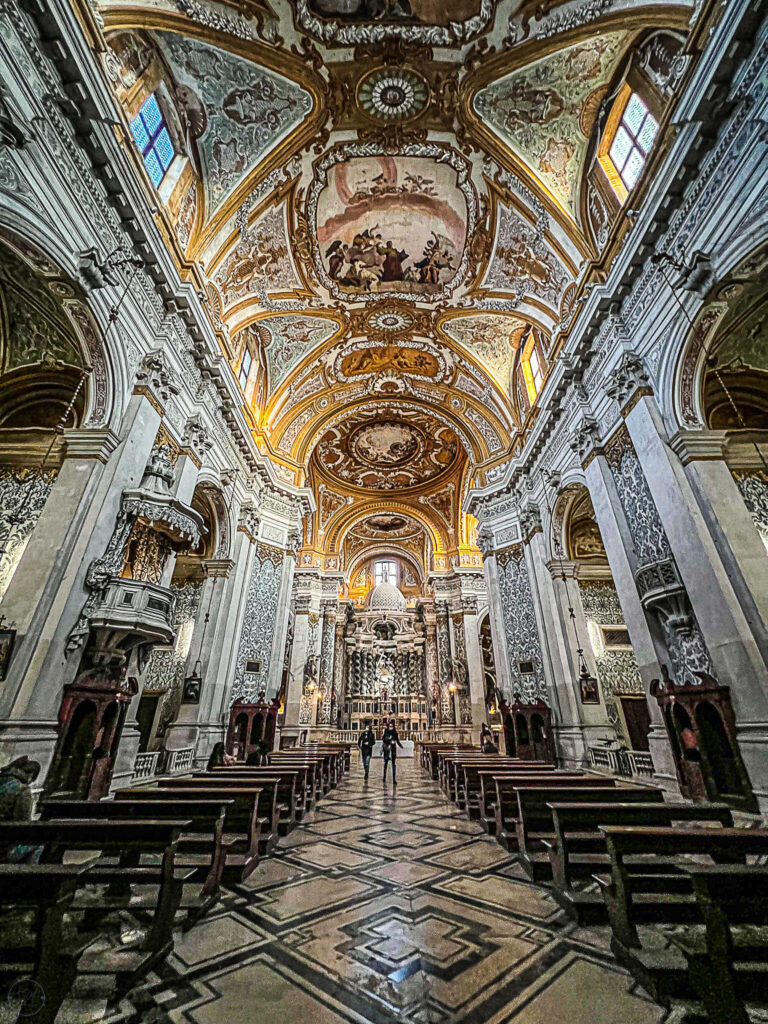
This church in the Canareggio district has an interesting history. In 1606, the Venetian Jesuit community was kicked out of the city for sixty years due to a disagreement between the Pope and the city. They decided to build a magnificent church to entice new patrons when they returned.
Inside the church completed in 1732, you’ll find masterpieces made of marble, from the statues to the high altar. Even the curtains of the pulpit are carved from marble. It costs a symbolic €1 to enter the Chiesa di Santa Maria Assunta detta I Gesuiti.
Learn at the Venetian Arsenal

The Venetian Arsenal was the Republic of Venice’s complex of shipyards and armories. It was built starting in 1104 and takes up about 15 percent of the total land space across the city.
No surprise for a nation built on a lagoon; the country controlled an enormous navy and merchant fleet. The kind of assembly-line mass production meant the Arsenal could produce a large number of boats very quickly, which had a significant, positive impact on Venice’s strong naval power.
Today, the Arsenal houses an impressive collection of weapons and armor at the Venice Naval History Museum and hosts events and exhibitions for the Venice Biennale. It’s also home to the operations center for the MOSE Project–a tidal barrier to try and combat the flooding and slow sinking of the city due to rising tides and climate change.
Attend the Venice Biennale

The Venice Biennale is an international arts festival held every other year starting in June and running through November. The exhibition features artists from all over the world. It is considered one of the largest and most prestigious events of its kind.
You can find out more about this year’s exhibitions and purchase tickets on their website.
Fun Fact: The Biennial was established in 1893 to showcase Italian art and celebrate the 25th anniversary of King Umberto I and Margherita of Savoy’s reign. The first officially opened on April 30th, 1895.
Explore the city’s Jewish Quarter


The Jewish Ghetto is an area within the old town of Venice where Jews were forced to live during the Middle Ages. Today, the site has become an open-air museum, housing many of the original synagogues, schools, and houses built by the Jewish community.
To learn more about the area’s history, make sure to visit the Museo Ebraico di Venezia (Jewish Museum of Venice.)
Quick History: The word “ghetto” comes from the “Italian dialect form ghèto, meaning “foundry.” A foundry for cannons was once located on an island that forms part of Venice, where in 1516 the Venetians restricted Jewish residence. The word ghèto became the name for the area and was borrowed into standard Italian as ghetto, with the meaning of “section of a city where Jews are forced to live.” From there it passed into most other European languages.”
“ghetto,” Merriam-Webster.com Dictionary. Accessed 3/13/2022.
Discover a classic at the Libreria Acqua Alta



One of my favorite things to do in Venice is to wander around the Libreria Acqua Alta. The Castello neighborhood bookstore has books and magazines piled up to the ceilings on shelves, in a bathtub, and in one of the most Venetian things I’ve ever seen–books piled high in a gondola.
Since it’s right along a canal, you can climb up a stairway of books to see the view, and they even have a gondola attached to their water-facing door so you can read sitting outside on the water.
It’s become so popular that it’s become an Instagram hotspot! If you’re lucky, you might even capture a picture of one of their cute cats roaming the shelves.
Walk along the Calle Giazzo

The Calle Giazzo is a metal walkway running between two vaporetto stops in the Castello district near the Venetian Arsenale. It’s a peaceful, peculiar place because you can see the lagoon underneath you while walking on a metal walkway between the Bacini – Arsenale Nord and Celestia water taxi terminals.
See the tombs of twenty-five Doges at the Basilica dei Santi Giovanni e Paolo
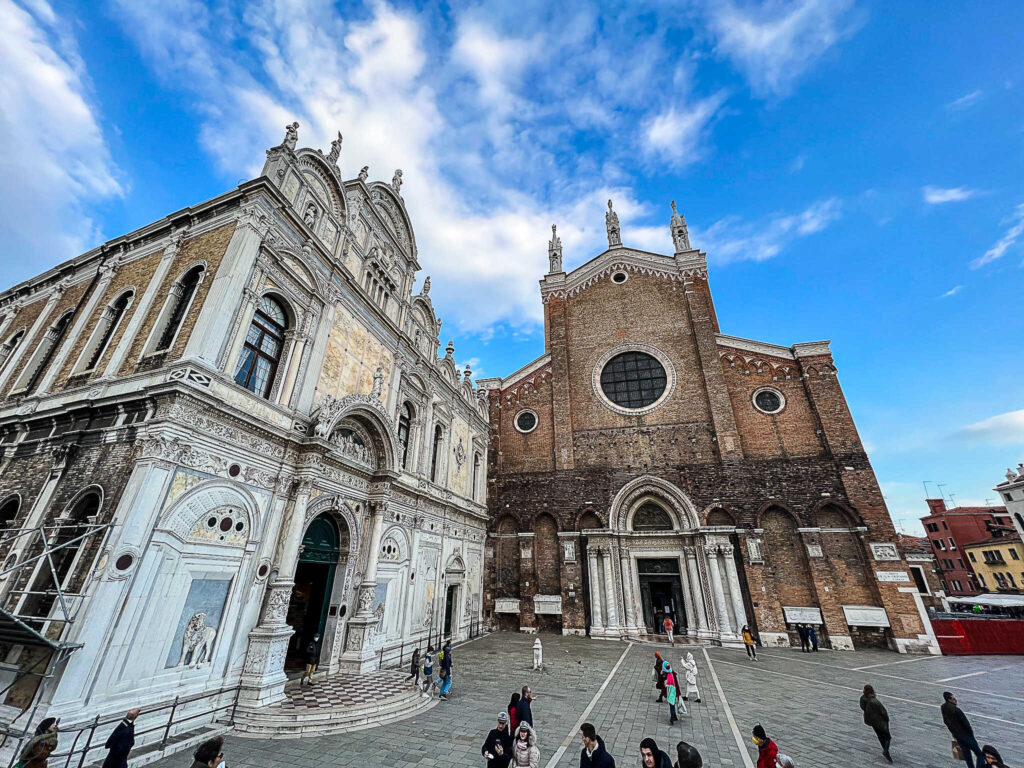
The Basilica of Saints John & Paul is one of the largest churches in Venice, located in the Castello neighborhood. From the 15th century until the end of the Republic of Venice, this is where the funerals for Doges took place and were buried.
As you walk around the inside of the church, you can see the tombs of the Doges, as well as many other famous Venetians.
Fun Fact: This church isn’t named for John the Baptist or Paul the Apostle. Instead, it’s named for two lesser-known martyrs from early Christianity.
Read More
- Day Trip to Venice from Florence: What to See with Limited Time
- The Ultimate European Summer Travel Packing List
- Your Guide for One Day in Trogir, Croatia
- Your Guide to the Best Museums in Ghent, Belgium
Take a day trip to a nearby city

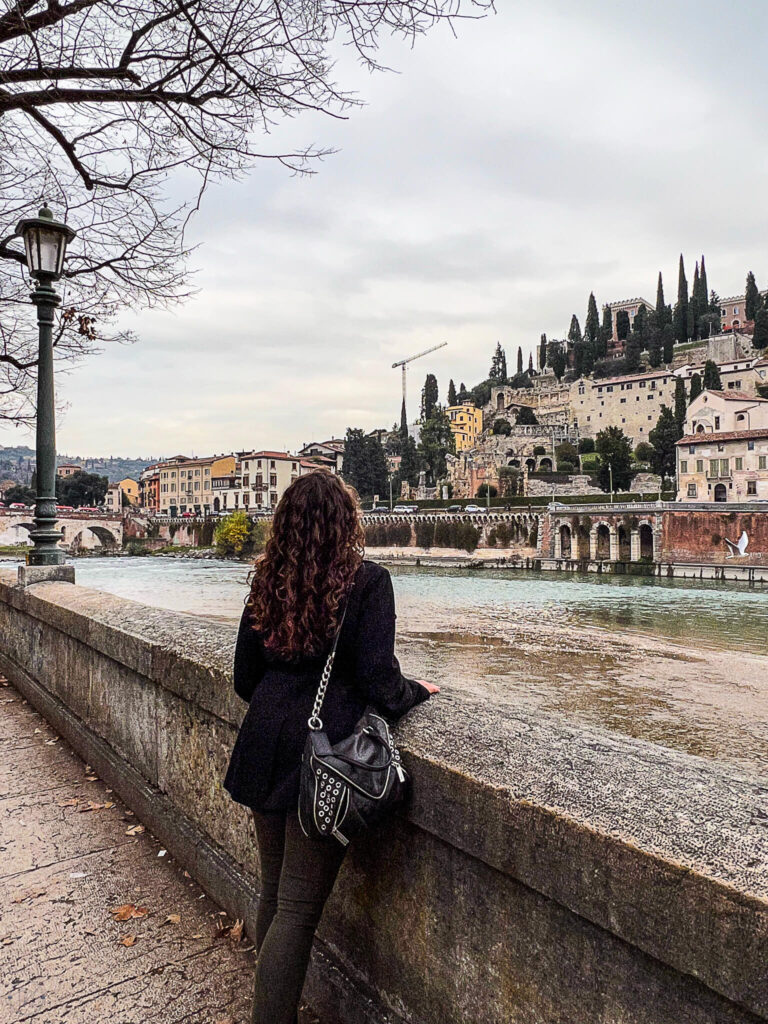
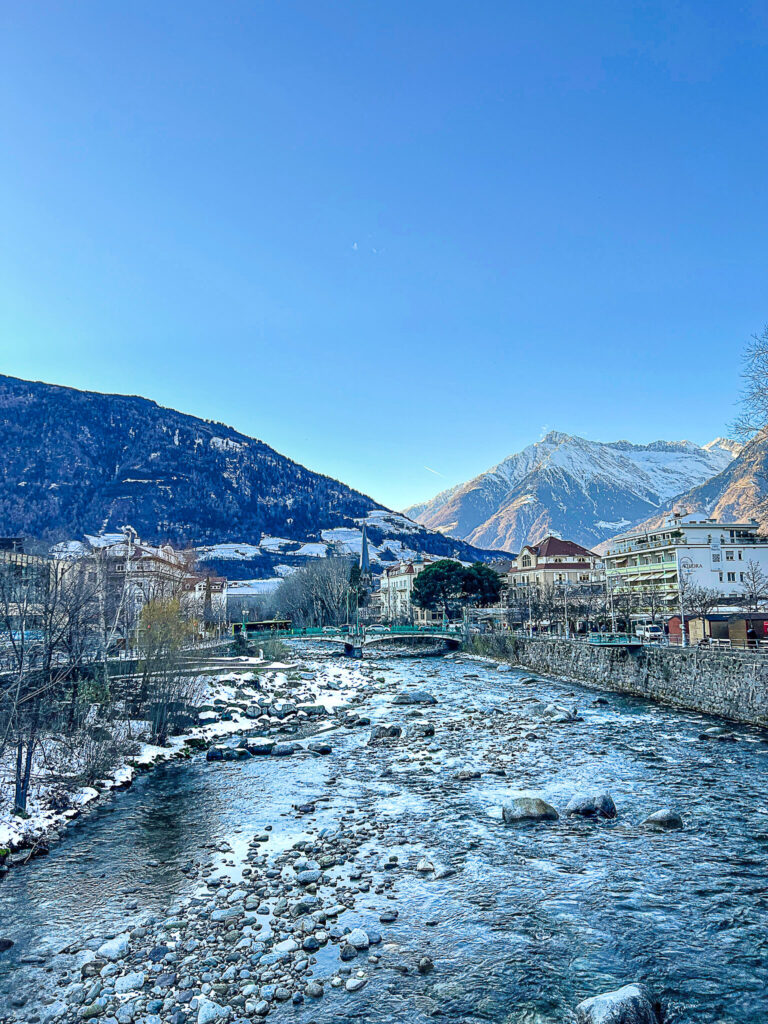
You should consider taking a day trip to a nearby town while visiting Venice. The north of Italy offers many beautiful towns and cities with a genuine Italian feel.
My top guided day trip recommendations include:
- Experience Italy’s dramatic mountain range of a Cortina & Dolomites Full-Day Tour
- Travel in style on a Padua Brenta Riviera Boat Cruise
- Take a day to visit fair Verona & Amarone
- Dedicate a whole day to a Prosecco Wine Tour and Tasting

If you’re willing to spend a night away from Venice, you can also take a ferry right from the city across the Adriatic Sea to Pula, Croatia.
I’ve lived with a local Croatian family for a few summers and loved my time in Pula.
You can check out my guides on how to take a day trip to Venice from Pula, things to do in Pula, the best beaches in Pula, and my 3-day itinerary to Pula if you want to learn more about this Croatian-Italian city.
Enjoy the view from the Fondaco dei Tedeschi rooftop

A few blocks from the Rialto Bridge, you’ll find the 14th-century Fondaco dei Tedeschi. This luxury indoor shopping mall was once the city’s main post office. Before that, German merchants living in the Venetian Republic were confined there.
The interior has been carefully designed to preserve the historical integrity of the structure while offering floors of shopping space. Shopping inside is one of the best things to do in Venice in the rain!
And now you can enjoy the panoramic views of the city from its rooftop as one of the best free things to do in Venice. It’s free to reserve a ticket to visit the T Fondaco Rooftop Terrace; just make sure to book your ticket in advance.
Swim on Lido Island

Who needs the Amalfi Coast when you have a spiaggia (beach) in Venezia?
The Lido is an island just off the coast of Venice where you can enjoy the sun, sand, and water without having to leave the city. You’ll find many seaside shops, restaurants, and hotels–and most of the coastline beach is free to the public.
There are plenty of beaches on the island, with Spiaggia Lungomare d’Annunzio, Venezia Spiaggia Blue Moon, and Murazzi Spiaggia libera as the most popular ones. If you’re lucky enough to visit during high season, expect crowds of people enjoying their time together.
I have a whole list of my favorite beaches in Venice if you’re interested in learning more.
Head inside the Church of San Giorgio Maggiore
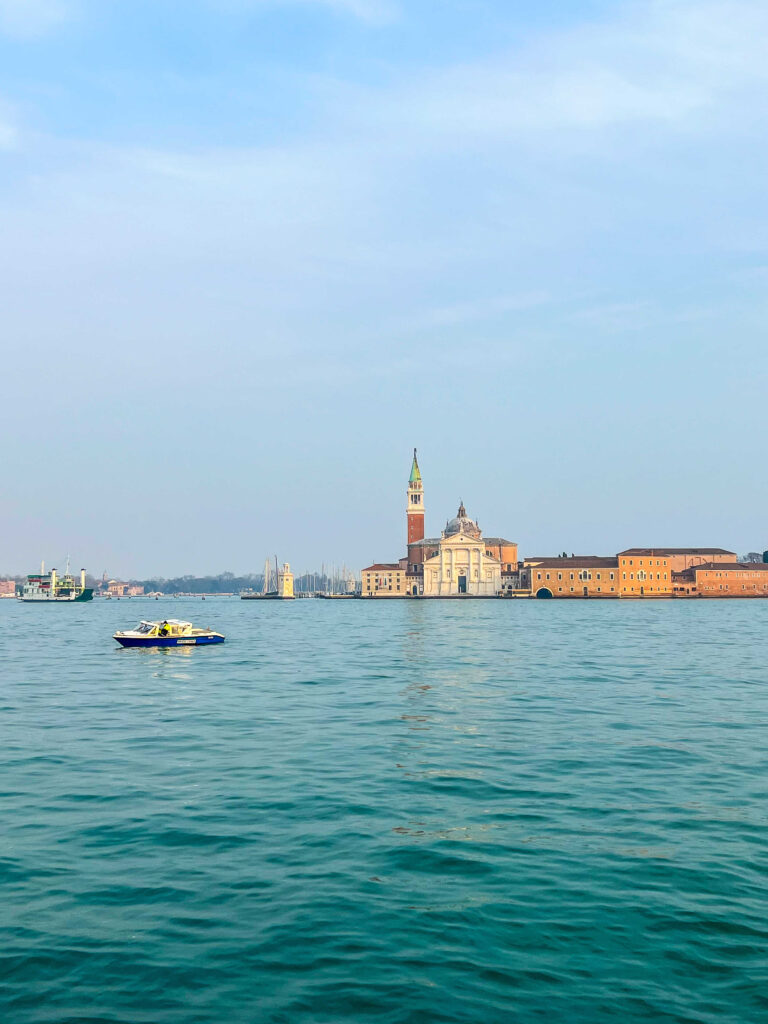
Also the name of the island it’s on, Chiesa di San Giorgio Maggiore is dedicated to Saint George and was home to the San Giorgio Monastery from 982 until 1812. When you visit the island, make sure you climb the bell tower. The Campanile di San Giorgio offers one of the best views of Venice; you can see the whole city laid out in front of you.
You’ll also find the Fondazione Giorgio Cini cultural center and library archive, the Labirinto Borges labyrinth, the open-air theater Teatro Verde, and the Vatican Chapels. You can reach the island by the city’s Vaporetto.
Fun Fact: The famous Impressionist painter Claude Monet captured the beauty of Chiesa di San Giorgio Maggiore within a series of paintings titled Saint-Georges majeur au crépuscule.
Visit the three other Venetian islands–Murano, Burano, and Torcello

Two of these three small islands off of the coast of Venice are almost as famous as the central city itself.
Murano is one of the most famous glassmaking centers in the world. The first glassmakers were brought to this small island in the Venetian Lagoon during the Middle Ages and prevented from leaving to keep their secrets on making glass. Today, Murano is still considered a center for high-quality glass production, and it’s where you’ll find the Museo del Vetro (Glass Museum).
Burano is home to the world-famous needle-lace. The island was revered for the quality of its lace during the 18th century, and the practice was even saved from extinction in 1872 by an elderly resident of the island who remembered how the lace was created. Unfortunately, the school is no longer in operation. Still, you can visit the Museo del Merletto to learn all about the art form’s history on this island. Burano is also famous for its colorful painted houses.
Torcello is the smallest of the three islands. Built in 639, it’s home to the Basilica di Santa Maria Assunta. It also has some of the oldest mosaics in the region, the Casa Museo Andrich art museum, and the Museo di Torcello.
You can either purchase a day pass for the vaporetto and go from island to island yourself in your own time, or book this guided tour to Burano, Murano, and Torcello. They’ll coordinate all your transportation, give you free time on each island, and your tour includes entry to a glass workshop and a stop to visit a lace shop. This is a great day trip to take if you’re visiting Venice, Italy in the summer!
See the alter and flooded crypt in Chiesa di San Zaccaria

Just around the corner from St. Peter’s Basilica, the first version of Chiesa di San Zaccaria was built in the 9th century for the remains of Saint Zechariah, the father of prophet John the Baptist, that still lay in the church.
The version that stands today was constructed next to the foundation of the original, starting in the 13th century in the late-Gothic and Renaissance styles. The San Zaccaria Altarpiece is one of the most famous works by Renaissance painter Giovanni Bellini, found in one of the church’s niches.
Chiesa di San Zaccaria was also where several of the doges were laid to rest, in the crypt below the church. Although that space is now flooded with canal water, you can still head underground and see the site. It’s actually even more beautiful with the standing water since it acts as a kind of mirror that reflects the columns and ceiling vaults, making it look even more majestic.
Check out what art exhibition is on display at Palazzo Grassi
Of all Venice’s palaces, Palazzi Grassi was the last one to be built on the Grand Canal before the fall of the Venetian Republic. French art collector François Pinault is the current owner of the building (and of Punta della Dogana). The space now showcases modern art in permanent and temporary collections. You can see what’s going on there now on their website.
Get a glimpse at historic fashion inside the Study Centre of the History of Textiles, Costumes and Perfume at Palazzo Mocenigo
Carefully rebuilt in the 17th century, Palazzo Mocenigo was originally owned by the powerful Venetian Mocenigo family. The last descent of the family bequeathed the building to the city to become a museum after his death in 1945.
The Study Centre of the History of Textiles, Costumes and Perfume officially opened 20 years later to showcase rare textiles, ancient clothing, and costumes. It’s also home to a library dedicated to clothing history.
From fine waistcoats for aristocratic Venetians to elaborate lace patterns and embroideries, you’ll see how wealthy residents lived through the historic fabrics and furnishings here in the museum.
See the city lights sparkle on the canals at night

There are many things to do in Venice at night, too. You can see the moonlight reflected on the water, feel the breeze blowing across the canals, and walk through the now almost-empty Piazza San Marco.
When you’re walking along the Grand Canal, you’ll notice how beautiful the buildings are lit up by the moonlight. And if you go to the Rialto Bridge, you’ll be amazed by the beauty of the bridge and the lights reflecting off the water.
Venice is beautiful, historic and full of amazing sights and experiences. The city is absolutely incredible and I hope you get an opportunity to check off as many of these Venice bucket list activities the next time you visit!
